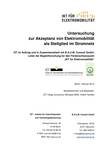Investigation into the acceptance of electromobility as an actuator in the electricity grid
Abstract
Renewable energy sources are becoming increasingly important, but their feed-in to the grids fluctuates and does not run parallel to the development of the demand for energy. Electric vehicles can make a decisive contribution to solving the resulting problems. This is because storage technologies are needed to exploit the potential of renewable energies. The batteries of electric vehicles are ideal for this purpose. Electric mobility and grid integration are thus an essential pillar of sustainable mobility and at the same time a central field of political action. The flow of energy between the grid and the electric vehicle can take place in two directions when the vehicle is used as a mobile storage unit: In times of energy surplus, the vehicle batteries can be used as storage in the grid-to-vehicle (G2V) direction, while in times of high energy demand, the energy can be released back to the grid in the vehicle-to-grid (V2G) direction. The term vehicle-to-grid (V2G) is also used - especially internationally - for the overarching concept of grid integration of electric vehicles, which integrates the two flow directions "from the grid to the vehicle" and "from the vehicle to the grid". Since holistic grid integration concepts and less the direction of current flow are relevant for the present study, V2G concepts are defined in such a way that they generally enable the integration of electric cars into the electricity grid via controlled charging or discharging. The present study "Investigation into the acceptance of electric mobility as an actuator in the electricity grid" is structured in two stages and first provides an overview of the findings of current electric mobility studies with references to acceptance research. Theoretically or empirically sound findings on user acceptance of grid integration concepts are virtually unavailable to date. In this respect, the available studies and the findings on the acceptance of electromobility gained in the course of pilot projects were evaluated as a whole. This makes sense insofar as the sufficient diffusion of electromobility is a necessary prerequisite for the successful implementation of grid integration concepts. Based on the findings of the literature study, central key factors of vehicle-to-grid concepts were derived and eight fictitious case studies for controlled charging and discharging were systematically developed.
Authors
Jonuschat, Helga; Wölk, Michaela; Handke, Volker
Source information
Title
Investigation into the acceptance of electromobility as an actuator in the electricity grid
IZT on behalf of and in cooperation with B.A.U.M. Consult GmbH, head of the accompanying research for the funding priority "ICT for Electromobility".
Year of publication
2012
Document type
Grey Literature/Report